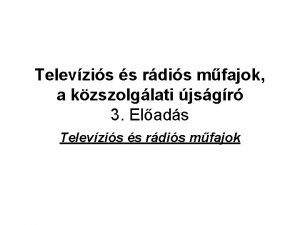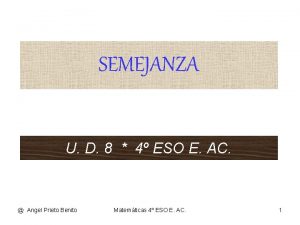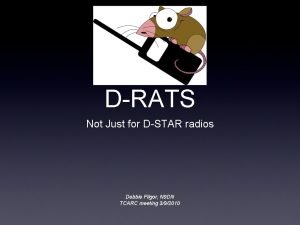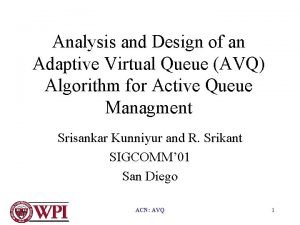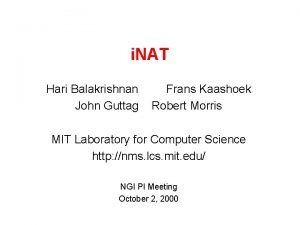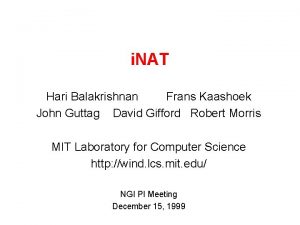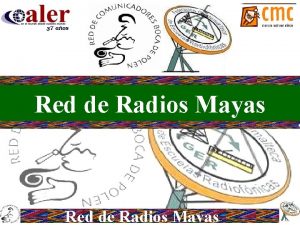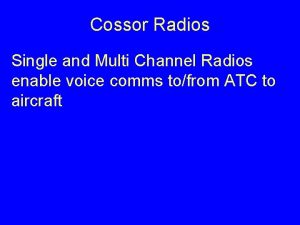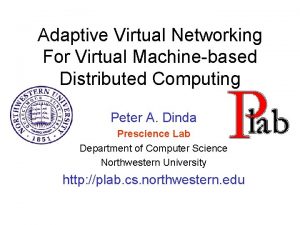Virtual Radios for Adaptive ApplicationSpecific Networking John Guttag










- Slides: 10

Virtual Radios for Adaptive Application-Specific Networking John Guttag Networks and Mobile Systems Group MIT LCS June 2000 John Guttag 0

Adaptive Wireless Networking Goal: Better communication (not better networks) Customize network on-the-fly Application-specific and condition-specific Different applications have different requirements Bandwidth, latency, error rate, security In a wireless network channel conditions Vary significantly over time Can be hard to predict Design for the actual case Not the worst (or even the average) case Oxygen couples applications and communications Provides perfect venue for adaptive networking June 2000 John Guttag 1

Digital Communication Source Many-one One-one Source Channel Encoder One-many Sink Channel One-one Many-one Source Channel Decoder Only the channel is out of our control June 2000 John Guttag 2

An Adaptive Wireless Network Interface OSI Layers Virtual Radio Layers bytes Link. Framing Data link Channel Coding bits Line Coding symbols Modulation Discrete signal Physical Multiple Access Discrete signal A/D Conversion Continuous signal Freq. Conv. Continuous signal 3

From Physical Radios to Virtual Radios Edison’s Radio Spectrum. Ware Radio pages = (Block. Size/4096) +1; if((guppi_open("guppi 0", pages)) < 0 ) exit(0); guppi_start_rec(); for ( i=0 ; i< Num. Blocks ; i++){ pdata = (char *)guppi_rec_buf(); for ( j=0 ; j< Ints. Per. Block ; j++){ Real. Tap_ptr=Real. Tap; Imag. Tap_ptr=Imag. Tap; Output. Data. Real = 0. 0; Output. Data. Imag = 0. 0; a=cos(Two. Pi * Center. Freq / (float)Sample. Freq. In * index); b=sin(Two. Pi * Center. Freq / (float)Sample. Freq. In * index); index += Dec. Factor; for ( k=0; k< Filter. Length ; k++, pdata++){ Output. Data. Real += ((float)*pdata * Real. Tap[k]); Output. Data. Imag += ((float)*pdata * Imag. Tap[k]); . . . June 2000 John Guttag 4

Ideal Software Radio Wideband Antenna Wideband ADC A/D Processor and D/A Memory RF Power Amp June 2000 John Guttag 5

Spectrum. Ware Virtual Radio PC AMPS TV Patch Panel PSpectra Environment Wideband IF Multiband A/D, D/A Frontend (33 MSPS) Gu. PPI June 2000 John Guttag Linux 6

A Short Demonstration June 2000 John Guttag 7

Research Goals Explore uses of communication between layers Adapt protocol based on transmission channel Adapt transmission to needs of protocol Explore issues related to mobility Configuration of ad hoc networks, security Including across multiple networks Explore issues related to dynamic resource allocation Especially energy and spectrum Explore application-specific networking at all levels Waveforms to services June 2000 John Guttag 8

Some Deliverables Development environment for signal processing Useful for both software physical layers and applications Novel algorithms Digital communications API connecting physical and higher layers Coordinated adaptation on a single node Mechanisms for coordinating adaptation across nodes Basically a protocol problem Prototype application Exploring medical applications with Center for Minimally Invasive Therapies at Partners’ Health Care June 2000 John Guttag 9
 Sdn vs traditional networking
Sdn vs traditional networking Unlicensed two-way radios
Unlicensed two-way radios Jsgr
Jsgr Dos circunferencias secantes tienen radios de 6 cm y 10 cm
Dos circunferencias secantes tienen radios de 6 cm y 10 cm Radios matra
Radios matra D star radios
D star radios Aaw radios
Aaw radios Elementos altamente electronegativos
Elementos altamente electronegativos Adaptive virtual queue management algorithm
Adaptive virtual queue management algorithm Has virtual functions and accessible non-virtual destructor
Has virtual functions and accessible non-virtual destructor Kontinuitetshantering
Kontinuitetshantering


